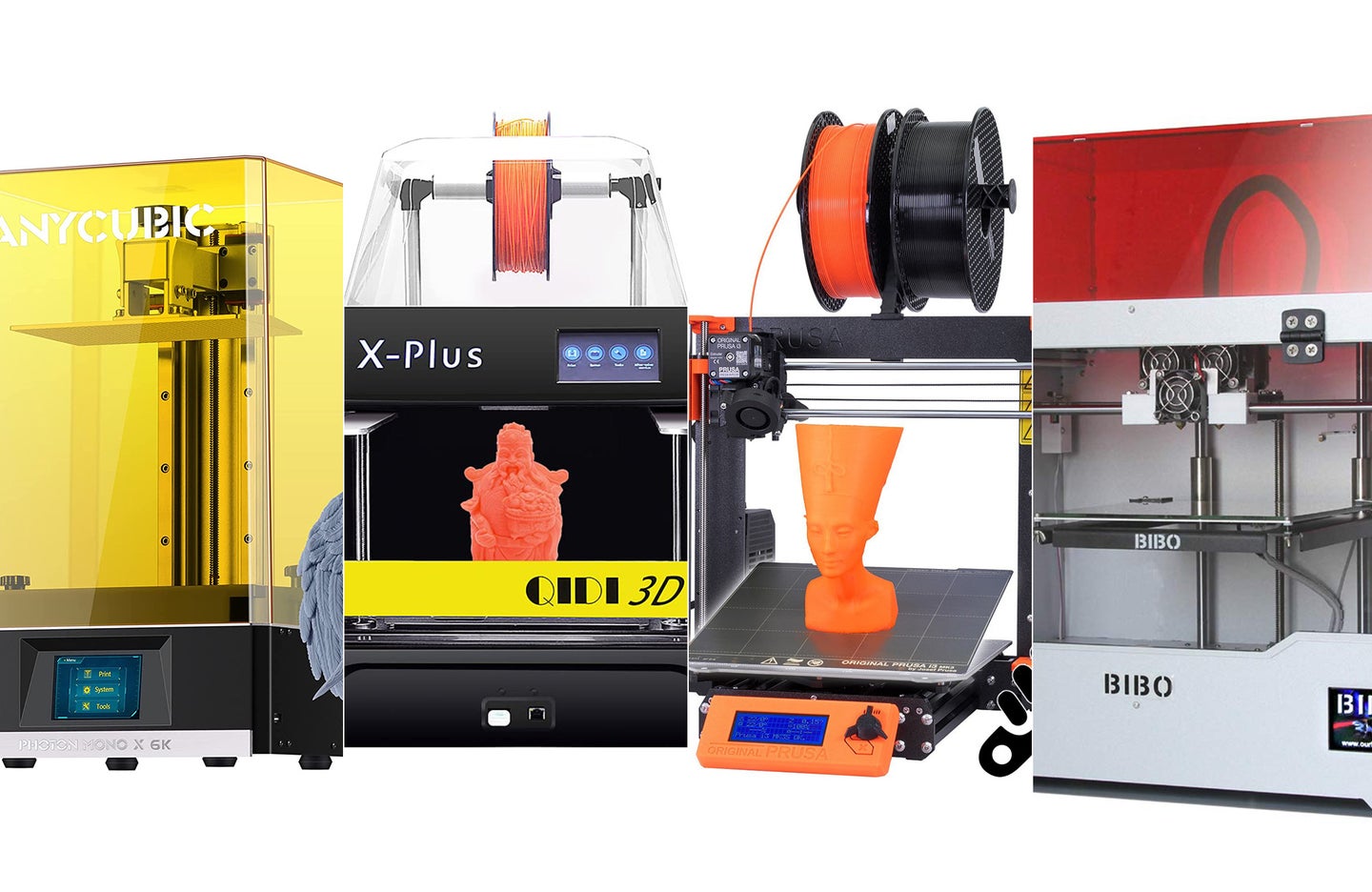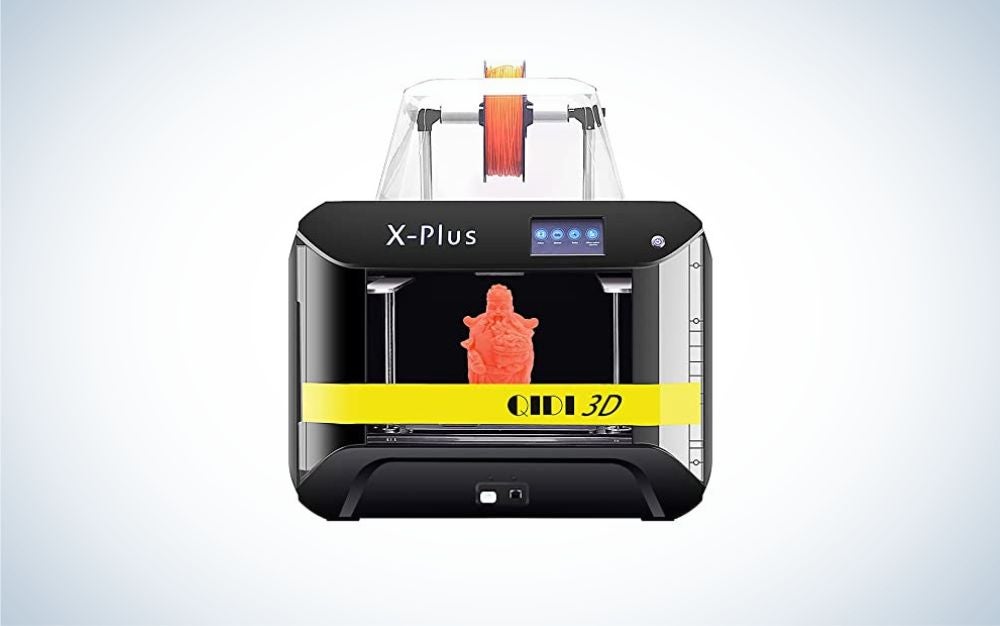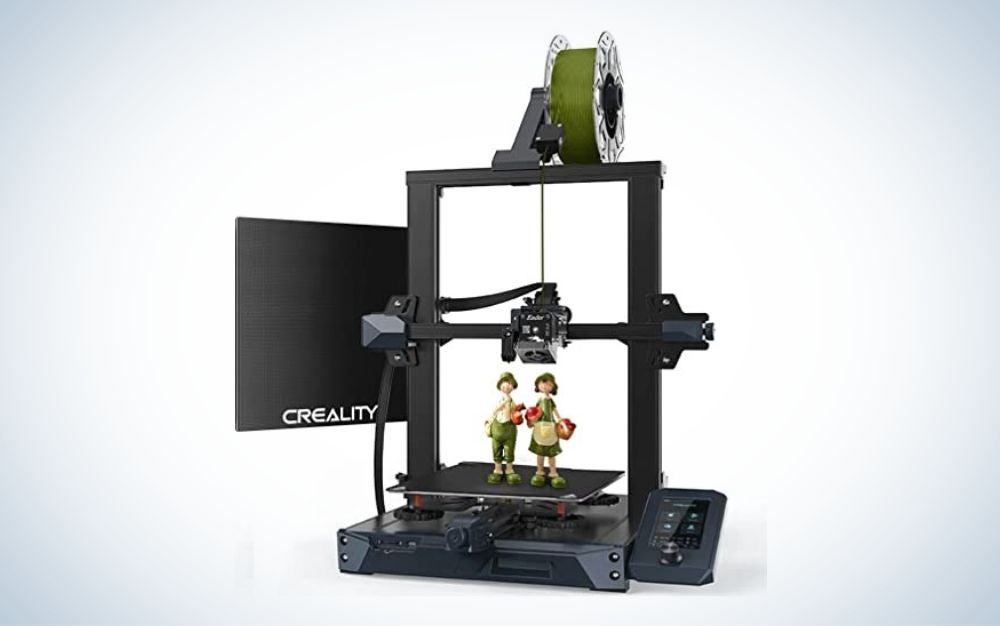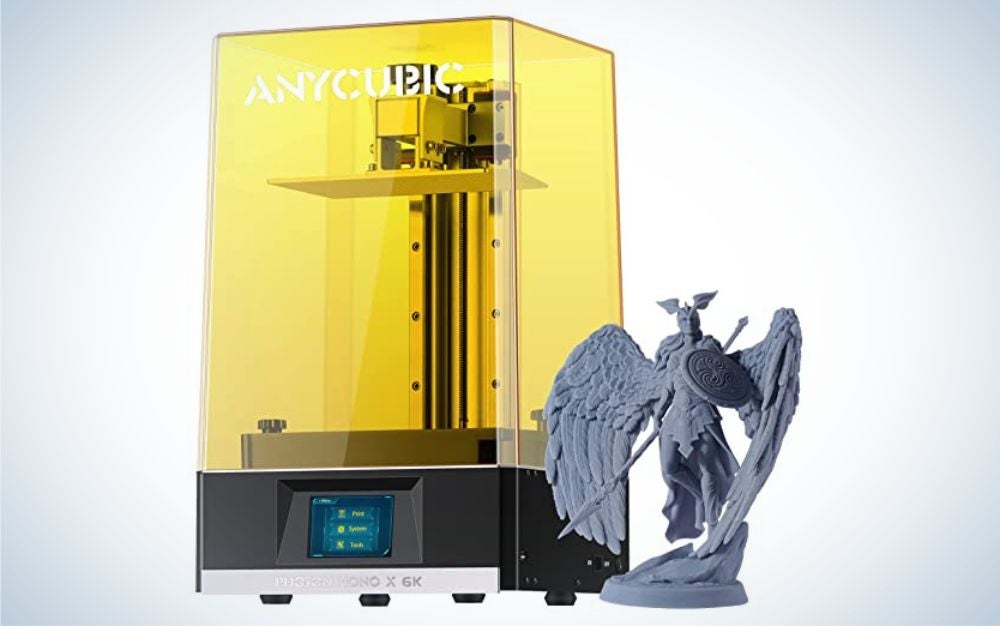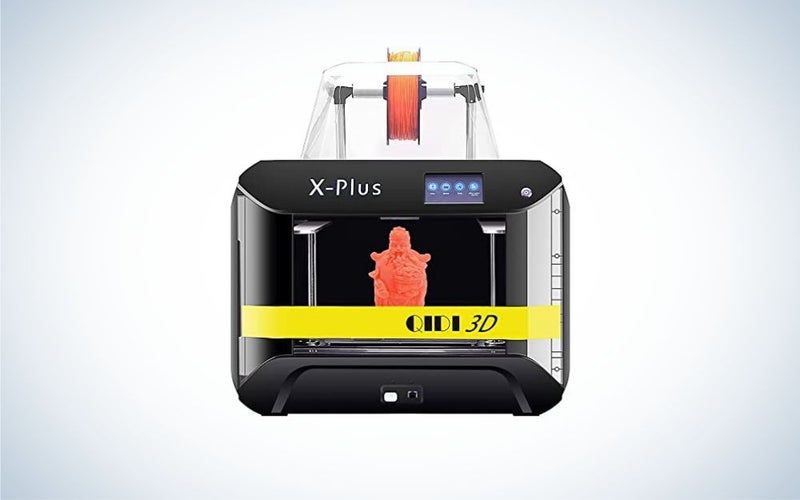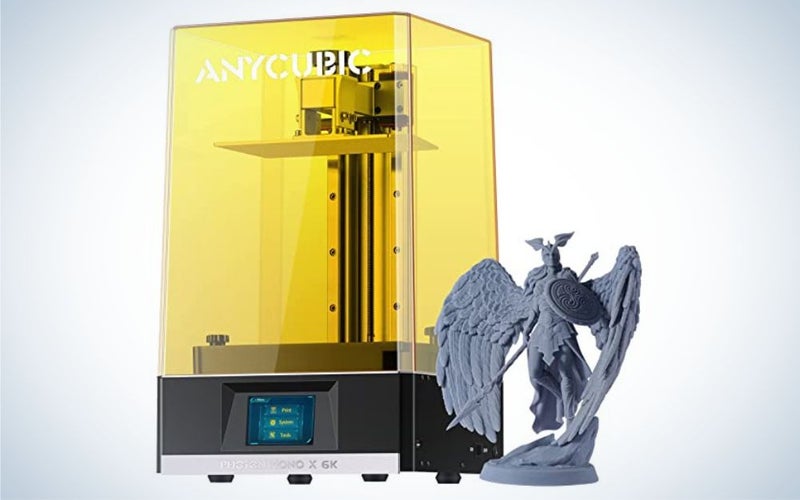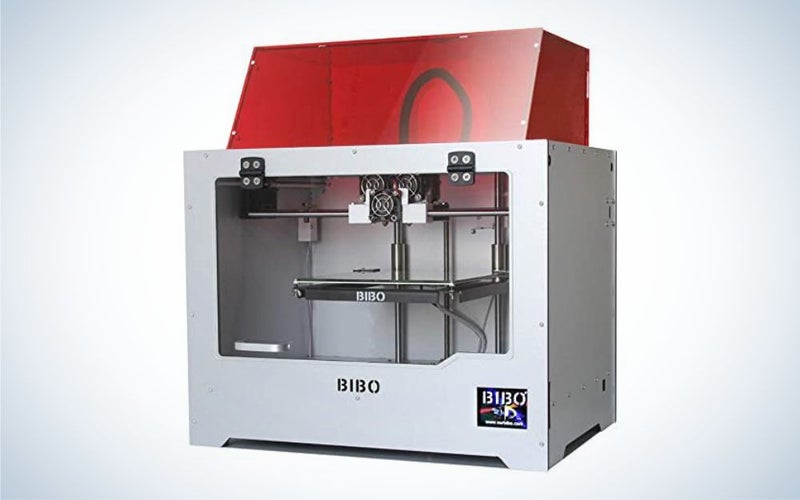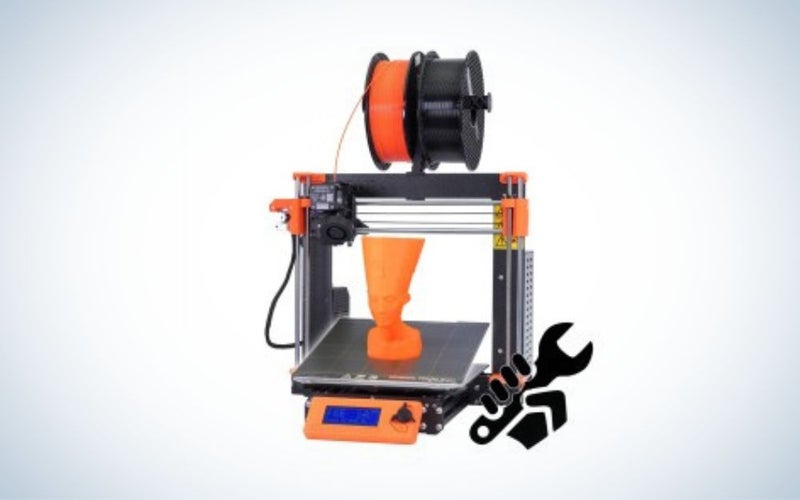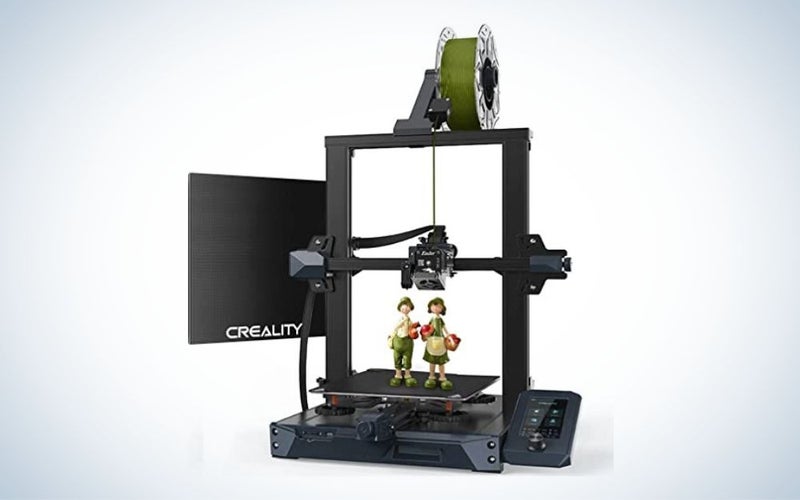We may earn revenue from the products available on this page and participate in affiliate programs. Learn more ›
Load up the filament, transfer your slices … the best 3D printers under $1000 have all the tools that most makers will need to give form to their visions. You might be a hobbyist separately printing and carefully-painting each gargantuan wing of the great gold-dragon for your next D&D campaign. Maybe you’re printing a grip for your old film camera to make it more comfortable to hold. Or perhaps you’re creating a custom prop for a photoshoot for much less than the cost of buying it. Whatever your aims, the best 3D printers under $1000 should give you enough power to achieve them. If you want to go even cheaper, you can check out the best 3D printers for kids.
This article focuses on 3D printers at the high-hundreds price-point, which still hover below $1000. At this price point 3D printers get quite capable, delivering some really great features like auto-leveling trays, blistering extruders capable of working with wider sets of materials (such as nylon), extremely high-resolution resin prints, air-filtration, quieter operation, better-connectivity, and dual extruders. Read on for a look at some of the best 3D printers under $1000, and just what it is that makes them so.
- Best overall: R QIDI X-Plus
- Best resin: ANYCUBIC Photon Mono X 6K
- Best dual extruder: BIBO 3D Printer Dual Extruder
- Best kit: Original Prusa i3 MK3S+ kit
- Best budget: Creality Ender-3 S1
How we picked the best 3D printers under $1000
Because there’s so much that goes into great 3D printers there were a lot of features to factor when we were researching the five best. We researched numerous printers from multiple manufacturers, looking for the best feature sets, wherein all parts collaborate for a gestalt of function that’s the most useful for the makers of today. Along the way we looked for a few specific features which we detailed below:
Versatility is always nice. At the mid-level price point below $1000, we start seeing FDM printers that are capable of nylon and some more advanced thermoplastics. We also start seeing SLA printers that are capable of more. We noted this wherever it stood out.
Tray functions are so important to overall printer quality. We looked for printers with trays that get hot enough to keep your models well-secured. We also looked for printers that have auto-leveling functionality, or at least excellent semi-auto leveling.
Extruder & LCD (or laser) quality is extremely important for 3D printing. Extruder quality plays a big role in which thermoplastics the printer can handle. Great extruders get hot, and are light enough to work well with the system. Different extruder dimensions also play into their use for different situations. Some systems even use two extruders. For SLA systems the LCD array (or laser) is extremely important in getting good print resolution and smooth forms.
Overall precision is achieved through lots of factors, but we like to see FDM printers with a multi-column lift system. We looked for FDM printers that don’t leave lines, burrs, or slice edges visible on the sides of the print. We also looked for SLA printers that yield high-res prints with smooth curves.
Connectivity & slicing software can define the quality of your print experience just as much as some of the more mechanical components of your system. Wireless connection is always nice, and printers with a few gigabytes of internal storage also offer a boon. Compatibility with lots of slicing software or one especially good one is also important and we noted this.
User experience and assembly also cannot be overlooked. Some printers get loud — we mean infernal giant-water-bears crawling from the pit sort-of loud (do water-bears roar?). Where we found printers that deal well with sound and fumes, we highlighted them. We also noted the required assembly of each printer. Some want highly customizable printers that might require longer assembly but are capable of modding, but not all do.
The best 3D printers under $1000: Reviews & Recommendations
Best overall: R QIDI X-Plus
R QIDI TECHNOLOGY
Why It Made The Cut: An FDM printer with easily-serviceable standard parts, an optional auxiliary-extruder that enables it to print more technical materials, and outstanding customer service.
Specs:
- Print technology: FDM
- Build size: 10.6 x 7.9 x 7.9 inches
- Supported materials: PLA, TPU, PETG, ABS, Nylon, PC, Carbon fiber, and more
- Best slicer software: QIDI Print Slicer (included free)
Pros
- Second extruder for technical-material free upon request
- Excellent customer service and support
- Very easy assembly & simple repair
- High res-smooth prints
Cons
- Manual bed leveling
- Wifi issues with non-QIDI software
Something of a plug-and-play machine, the R QIDI X-Plus is a highly capable FDM printer that has an expanded range of materials, possible via a free supplementary extruder. With easily repaired standard parts, and great customer support, it’s an easy best-overall choice for most.
Shipped from China, the semi-enclosed X-Plus takes hardly any set up. It comes with a standard extruder suitable for PLA, ABS, and TPU. A second technical-material extruder is also available with your purchase free of charge by request (which belies the companies communication-forward ethos), and is capable of materials like Nylon, PC, Carbon fiber, and more. To be clear, this second extruder is swappable, rather than supplementary, this isn’t a dual-extruder rig, and the second extruder won’t work in tandem with the standard. However, the technical nozzle is a nice touch, that firmly differentiates this machine from cheaper FDM’s in the sub-$500 price range.
QIDI is all about customer support and easy repairs. Not only are the majority of the parts in this system standard and easily replaceable, but the majority of replacements are also easy to DIY, with included tools for most hardware in the system. QIDI offers exceptional customer service, with knowledgeable agents ready to send you repair parts as needed, and help troubleshoot issues.
While the X-Plus doesn’t have the automatic leveling you might like at this price point, it does have a semi-auto, single-point quick-level system that is reliable and easy. It features QIDI Print Slicer software, that’s free to use with any QIDI system All-in-all, while this system might not be as appealing to hardcore tinkerers as some, those who want consistent quality with easy set-up, good customer support, and a wider than average range of available materials will love it.
Best Resin: ANYCUBIC Photon Mono X 6K
ANYCUBIC
Why It Made The Cut: 6K LCDs mean better resolution than ever, with more detail and contrast, more build volume, and faster speeds.
Specs:
- Print technology: SLA
- Build size: 9.6 x 7.8 x 4.8 inches
- Supported materials: Resin
- Best slicer software: Anycubic Photon Workshop (free), ChiTuBox, Lychee, more
Pros
- Extreme print detail and resolution
- Great contrast
- Fast, at up to 1s / layer in some instances
- Great out of the box prints
Cons
- Poor connectivity options
- Very smelly
6K — that’s a lot of LCDs, and the ANYCUBIC Photon Mono X 6K leverages them all for extremely high-resolution prints with impeccable contrast. ANYCUBIC is one of the most popular lines of SLA resin printers, and the Photon Mono X is one of the most impressive dogs in the pack.
With its 6K LCDs the Photon Mono X 6K uses a 9.25-inch monochrome LCD array, with 6% light transmittance, which means quicker printing. The machine is fast, and ANYCUBIC brags up to 1s / layer, in ideal circumstances. Its LCD’s deliver extreme contrast that’s noticeable, and the model sports a much larger build area than its cousins, at 9.6 x 7.8 x 4.8 inches.
ANYCUBIC is compatible with lots of great slicer software packs, from ChiTuBox, to Lychee, and offers the proprietary Anycubic Photon Workshop free of charge. Sadly, getting your slices to the printer is more difficult than it could be, as the printer’s Wifi is notoriously spotty. It’s built around its LCD screen control and SD card reader, meaning SD is the best way to play. Those who like to keep their SLA printer on a well-ventilated back porch will appreciate not having to keep their printer connected to a laptop, but those who want to set up a printer farm might groan. Otherwise, it’s a great buy, offering some of the best quality resin prints out there.
Best dxtruder: BIBO 3D Printer Dual Extruder
BIBO
Why It Made The Cut: Solid dual extruder support means lots of techniques you can’t get at with other FDM printers, plus WiFi and a touchscreen make it easy to use.
Specs:
- Print technology: FDM
- Build size: 8.4 x 7.3 x 6.3 inches
- Supported materials: ABS, PLA, Dissolvable filament (PVA, HIPS), TPU, PETG, Nylon, PC, Carbon fiber, and more
- Best slicer software: Repetier-Host, Cura, Simplify3D
Pros
- Dual extruders
- Minimal easy assembly
- Wifi control
- Good customer support
Cons
- Difficult maintenance and usability
- Bed isn’t easy to level
If you’re moving up from a basic machine, the BIBO 3D’s dual extruders can open doors you didn’t even know were closed. These include printing dissolvable supports, printing with multiple colors, and 3D printing two duplicate objects simultaneously. But these dual extruders aren’t the BIBO 3D’s only bargaining chip.
BIBO 3D does a good job with a wider range of materials. Beyond the standards like ABS and PLA, it prints more technical thermoplastics like flexible nylon, and carbon fiber. The system uses an easy touch-screen control panel to set up prints, and can also be controlled via Wifi, meaning you can control it from your phone.
The machine does have a couple of blindspots. Its leveling control isn’t as intuitive as you would expect at the price point. The machine is also packed tight with features, with screws in odd places, and somewhat abstract engineering overall. These issues are offset by great customer service from the company, but they do make the machine’s usability somewhat less optimal than some of the competition. It’s a great option for tinkerers who want extra extruders and wider material possibilities, but in spite of its initial assembly, it may be more hands on than some want.
Best kit: Original Prusa i3 MK3S+ kit
prusa3d
Why It Made The Cut: Taking a DIY ethos all the way, the Prusa i3 kit is open-sourced and powerful, with a state-of-the-art-extruder, exceptional leveling, wide filament support and more.
Specs:
- Print technology: FDM
- Build size: 9.84 × 8.3 × 8.3 inches
- Supported materials: PLA, PETG, ASA, ABS, PC (Polycarbonate), CPE, PVA / BVOH, PVB, HIPS, PP (Polypropylene), Flex, nGen, Nylon, Carbon filled, Woodfill
- Best slicer software: PrusaSlicer (proprietary), open source
Pros
- Mesh bed leveling details leveling for every print
- Excellent extruder that can handle an extra wide set of features
- Open source with strong user base for help with all sorts of mods and use cases
- Easy to remove prints
Cons
- Kit requires detailed and rigorous assembly
- Long lead-times for production, allow weeks before it arrives
You can’t get far into 3D printing turf without hearing the name Prusa, and it’s not hard to see why with the Original Prusa i3 MK3S+ kit (an assembled version is also available for a couple hundred more). This kit is a DIY maker’s dream, including some of the best tools in its class for 3D printing.
There’s a few things that make the Prusa i3 special, but we’ll start with its basics. It features a state-of-the-art extruder, as well as an excellent filament monitor. The extruder can handle a much wider than average set of filaments, including the standards, as well as nice additions such as woodfill, and abrasive nylon carbon-fiber. The printer also features an excellent fully automatic bed-leveling system that checks your bed before every print. If that’s not enough, its removable spring steel-sheets make it easy to extract your finished print.
In the end the Prusa i3 is one of the best options out there at the under $1000 price-point, and debatably beats out our top overall pick, the R QIDI X-Plus. However, for the Prusa to reach its full potential this machine requires an operator and builder who rejoices in getting through the weeds that are a major part of its construction, and making it out the other side. This is a printer for tinkerers and DIY makers, and when it’s well understood and loved, it can do wonders.
Best budget: Creality Ender-3 S1
Comgrow
Why It Made The Cut: Markedly more affordable than the rest of the printers on this list, the Ender-3 offers some pro level prototyping features, in an upgradeable build that’s priced for beginners.
Specs:
- Print technology: FDM
- Build size: 8.6 x 8.6 x 10.2 inches
- Supported materials: PLA, TPU, PETG, ABS
- Best slicer software: Open source (No preferred), Cura, Simplify3D, PrusaSlicer
Pros
- Open sourced and upgradeable
- Very precise extruder with dual lift
- 16 point auto level
- Easy assembly
Cons
- Loud prints
- Limited feature set compared to more expensive options
Our pick for the best 3d printer under $500, the Creality Ender-3 S1 is still worth a look, even if your possible budget could maybe allow for something pricier. Alongside Prusa, Creality’s Ender series is ever recognizable, and potentially the best known series for beginners. This open-source and expandable system gives you more room to print with than some systems that cost twice as much. With an extruder that hits 500 degrees Fahrenheit it’s also not that restrictive in comparison. Sure it won’t take care of more technical materials, but it does better than most, and if you’re new that might not matter.
One of the S1’s standout features is a 16 point auto-leveling system that makes sure your print bed is up to the challenge every time, it also features a removable spring steel-plate, a power-loss recovery feature, and a filament sensor. It delivers solid precision, with a dual-motor design.
While the S1 doesn’t have some of the top features found in models that retail closer to $1000, it’s still an exceptional hobbyist’s 3D printer that’s capable of doing a lot. It’s a great foundation that can be expanded on significantly with mods.
Things to consider when shopping for the best 3D printers under $1000
The best 3D printers under $1000 are stuffed full of tech, from their blistering-hot extruders, to their auto leveling trays, to WiFi, and 4k+ LCD arrays for curing liquid resin, Even the Bowden mechanism that’s often used to channel filament comes from an important invention for bicycle construction. With so many mechanical inventions and systems crammed into one device, 3D printers are inherently technical. Because of this, it’s a good idea to familiarize yourself with some parts of how the technology works before you buy.
With the first functional 3D printers built in the 1980s, 3D printers didn’t begin to pervade the mass market until the 2000s. While a few inventors and scientists were concurrently working on different elements of technology that would be incorporated into the 3D printer systems of today, Bill Masters was the first inventor who filed a 3D printer patent.
The inventor was camping on the banks of the Chattanooga river one night, staring up at the stars, when the idea came to him. He imagined using one star as a seed point, and then combining the other dots of starlight to create any shape he liked. His analogy for the additive manufacturing process that defines FDM printers of now, is great, likening the tech to “spit wads,” similar to the ones so many children familiarize themselves with at a day in the mall, “When you shoot a lot of wads, they begin to take shape. If you can control the direction of the wads and the motion of the device shooting them, you can produce any desired shape.” We love it.
3D Printer types
While there are numerous classes of 3D printers, there are three main families. These are fused deposition modeling (FDM), stereolithography (SLA), and selective laser sintering (SLS). Selective laser sintering uses a laser to fuse powdered material, which is distributed across a bed with a roller. SLS printers are capable of delivering strong functional prints that are sturdy enough for immediate incorporation into manufactured systems. However, the SLS process is very expensive, and is out of reach for most DIY tinkerers. The best 3D printers under $1000 in this article focus on FDM and SLA printers.
Fused deposition modeling
FDM printers are the most common and economical 3D printers on the market. These printers use a superheated nozzle to extrude filament downward onto a heated, leveled tray, building the model up slice-by-slice. FDM printers are suitable for quick prototyping, proof of concepts, and finished projects, and tend to be more economical and user-friendly. FDM printers usually also deliver a greater build area than SLA printers for the price.
Thermoplastics in FDM printers
FDM printers create objects out of thermoplastics. These common plastics have chemical properties that allow them to melt, form into a shape, and then melt again. These plastics are inherently recyclable, and many are quite cheap. The most common thermoplastics used in FDM printers include ABS, PLA, PETG, and TPU. Some also print nylon, and more.
These thermoplastics have different properties, some are food safe, while others are biodegradable, others are non-toxic for skin contact. However, the manner in which thermoplastic deposits fuse is primarily mechanical, rather than chemical, which runs the risk of leaving voids (or open spaces) in the walls of the print, which leads to inferior structural integrity on the Z axis.
Stereolithography
SLA printers use a different process from FDM printers, whereby a laser, or LCD array cures resin in a liquid resin bath, and extrudes it upwards slice by slice. These printers fuse the print onto a heated tray, and lifts it, upside-down, from the liquid resin. They are capable of printing parts and models with greater structural integrity and detail. Because of their high print resolution, SLA printers are the go-to for most hobbyists looking to build intricate models and figurines.
Thermosets in SLA printers
SLA printers use thermosetting plastics (thermosets). These resins cure into shape, and cannot be heated to dissolve, rather, heat causes their decomposition. This means that thermosets are not recyclable. However, the curing process of resins give them superior structural integrity to thermoplastics, as the plastic chemically fuses, creating covalent bonds between molecules. These resins achieve prints with better detail, resolution, and strength. Thermoset variety is also wide, including clear resins, wiggly resins, high temp resins, and even dental grade resins.
FAQs
Q: Which type of 3D printing is the cheapest?
FDM, or fused deposition modeling 3D printers are usually the cheapest, both in terms of up front cost and the cost to replenish their filament over time. They use an additive manufacturing process whereby they apply layers of molten thermoplastics onto a heated tray.
Q: What are the best 3D printers under $1000?
The best 3D printers under $1000 for most users is the R QIDI X-Plus. Arriving pre-assembled, this partially enclosed FDM printer is easily serviceable, precise, good for high-quality prints, and is capable of printing a wide array of filaments. QIDI also delivers great customer support.
Q: Which brand 3D printer is best?
There are lots of great 3D printer brands. Creality does a great job with powerful hobbyist printers for affordable prices. Prusa makes incredible open sourced printers with some of the best tech around. QIDI is known for precise, easy to use printers with excellent customer support. ANYCUBIC makes exceptional high-res SLA printers. ELEGOO also makes wonderful SLA printers. The best brand is the brand that brings the feature set you need.
Q: Is it profitable to buy a 3D printer?
As with any craft business, 3D printer craft can turn a good profit, however, how profitable it will be will depend upon your business practices. Before you invest in a business based on a 3D printer, consider all the factors that will contribute to your business.
Q: Can 3D printers can be acquired for less than 1000?
Yes, there are many excellent printers that can be acquired for under 1000. There are even some good ones that cost less than $200.
Q: Do you need a computer for a 3D printer?
In some form, you do need a computer for a 3D printer. However, some work-arounds are possible. If you want to buy a 3D printer and can’t afford a computer as well, consider downloading files from your library or school computer and using an SD card to print them on your 3D printer at home.
Q: Is an enclosed 3D printer better?
In some instances enclosed 3D printers are better. Many enclosed 3D printers come preassembled and are easy for beginners to plug in and get started with. Also, 3D printers can emit harmful fumes and light. Most SLA printers, which use bright curing LCDs and / or lasers, feature a UV shield. FDM printers can also benefit from the protection and structural integrity that enclosures provide.
Final thoughts regarding the best 3D printers under $1000
With so many features and advanced processes spun into one functional system, the best 3D printers under $1000 offer astounding feats of engineering, synergized to work together, to bring wildly powerful tools of creation into your workshop. They are used by everyone from design firms who might be prototyping a new invention, to hobbyists building a fleet of figurines. For the best DIY maker’s tool in its class, we recommend the Original Prusa i3 MK3S+ kit. If you’re looking for top notch resolution, you can’t go wrong with the ANYCUBIC Photon Mono X 6K, which is the best SLA 3D printer at its price point. If you want something that’s a little on the cheaper side, the Creality Ender-3 S1 is the best for beginners, and offers a large build space and solid tools. Finally, if ease of use is your prerogative, we recommend the R QIDI X-Plus, as the best overall 3D printer for most users — it might not offer as much tweakage potential as the Prusa i3, but with the X-Plus you’ll be printing great materials within two hours of the package arriving at your door.
